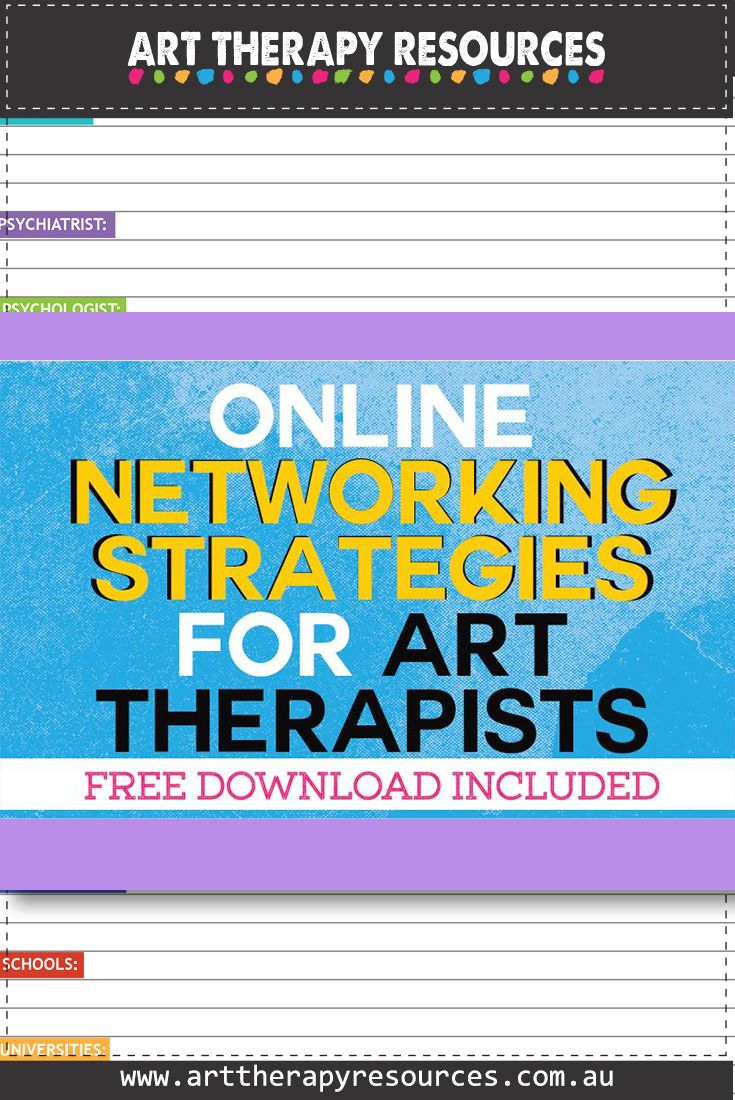THIS POST INCLUDES:
1. Importance of Networking
2. Planning Networking Activities
3. Your Online Presence
4. Free Download Network Contact Details Template
IMPORTANCE OF NETWORKING

Networking in the field of art therapy is more than just exchanging business cards; it’s about cultivating meaningful connections. Art therapists can develop these connections for continuous learning, sharing insights, and staying abreast of industry trends. The art therapy community is rich with diverse experiences, and networking offers a platform to tap into this collective wisdom.
Establishing professional connections in art therapy is aimed at cultivating relationships. Art therapists can harness the potential of these connections for learning, knowledge-sharing, and remaining aware of industry administrative and practical changes. The art therapy community becomes an invaluable source of diverse insights and perspectives through this strategic networking.
Practical Steps: We’ve identified some practical steps you can undertake to help you develop networking strategies.
a. Identify Target Networks: Art therapists should discern the networks that align with their professional goals and interests. These may include local art therapy associations, online forums, or specialized groups focused on specific therapeutic modalities.
b. Engage in Community Events: Actively participating in community events, workshops, and conferences is useful for networking. Attendees often share a commitment to advancing art therapy and create an environment conducive to meaningful connections.
c. Leverage Social Media Platforms: Utilize social media platforms dedicated to art therapy professionals. Platforms like LinkedIn, where professionals converge, and specialized art therapy forums foster virtual networking opportunities.
d. Initiate Conversations: Proactively initiate conversations with peers, mentors, and industry experts. Exchange insights, experiences, and seek advice, fostering reciprocal relationships.
e. Collaborate on Projects: Collaborative projects serve as catalysts for networking. Engaging in joint initiatives with other art therapists not only enhances professional visibility but also fosters camaraderie within the community.
f. Participate in Professional Development: Enroll in workshops, seminars, and training programs. These settings provide structured environments for networking while enhancing professional competencies.
g. Contribute to Publications: Sharing expertise through articles, blog posts, or research publications establishes professional credibility. It attracts like-minded professionals and invites opportunities for collaboration.
Through some of the above steps, art therapists can develop meaningful connections that contribute to a vibrant professional network that essential for sustained growth and excellence in the field of art therapy.
Unlocking Referral Opportunities Through Networking
Establishing a robust network opens doors to referral opportunities. Art therapists can connect with professionals from related fields, such as psychologists, counselors, or healthcare practitioners, to create a referral network. This collaborative approach not only expands the therapist’s reach but also enhances the quality of care provided to clients.
Cultivating a robust professional network serves as a key driver for unlocking referral opportunities. Art therapists can strategically engage with professionals in allied fields, including psychologists, counselors, and healthcare practitioners, thereby establishing a comprehensive referral network. This collaborative approach not only broadens the therapist’s sphere of influence but also elevates the standard of care afforded to clients through interdisciplinary collaboration.
Practical Steps: We’ve identified some practical steps you can undertake to help you develop referral opportunities.
a. Identify Collaborators: Art therapists should identify professionals in related fields whose expertise complements and augments the therapeutic services they offer. This may include psychologists specializing in trauma, counselors focusing on mental health, or healthcare practitioners dealing with specific client demographics.
b. Attend Events: Actively participate in events that attract professionals from various disciplines. Conferences, workshops, and seminars provide fertile ground for networking with potential collaborators.
c. Establish Clear Communication Channels: Develop clear and concise communication channels with allied professionals. Clearly articulate the scope of art therapy services, highlighting the complementary nature of the collaboration to ensure a mutual understanding of the potential referral process.
d. Offer Professional Development Workshops: Organize or participate in professional development workshops that showcase the benefits of art therapy. This not only positions the art therapist as an expert in their field but also educates allied professionals about the efficacy of incorporating art therapy into client care.
e. Utilize Online Platforms: Leverage online platforms, such as professional forums or collaborative spaces, to connect with allied professionals beyond geographical constraints. Virtual networking facilitates dialogue and collaboration in the digital space.
f. Maintain Regular Contact: Regularly nurture professional relationships through periodic communication. Stay informed about each other’s practices, ensuring that the referral network remains dynamic and responsive to evolving client needs.
By implementing these practical steps, art therapists can leverage strategic networking not only to expand their professional reach but also to establish a robust referral network that enhances the overall quality of care delivered to clients through interdisciplinary collaboration.
PLANNING NETWORKING ACTIVITIES

To navigate online networking successfully, art therapists can benefit by using a strategic approach to help connections develop as well as continue working with their private practice demands.
Before diving into networking activities, art therapists should define clear goals. Whether it’s expanding professional knowledge, securing referrals, or finding potential collaborators, having specific objectives provides direction and purpose to networking efforts.
The virtual landscape has opened new avenues for networking through online activities. This includes participating in industry-specific virtual events to connect with professionals, share insights, and explore potential collaborations. These online gatherings provide a platform to engage with a broader audience.
Because of potential conflicts with ethical social media use, it’s important for Art Therapists to consider their use of specific platforms online to ensure confidentiality, privacy, and ethical interactions are maintained at all time with various parties that form part of a potential online network.
Practical Steps: We’ve identified some practical steps you can undertake to help you plan networking activities.
IDENTIFY NETWORKING OBJECTIVE:
Art therapists should delineate clear objectives for their networking activities to ensure that they undertake the most effective steps with the limited time they may have available for networking. This involves specifying the types of connections sought, such as peers for professional discourse, potential collaborators, or individuals offering referral opportunities.
SEGMENTING TARGET AUDIENCES
Understanding your target audience within your network will help narrow down the potential avenues of connecting with other people in your network. This could mean focusing on networks with specific expertise in mental health issues, or developing connections with people based on their industry connections. Once you understand your audience, you can begin to be specific about developing your networks in the most efficient manner.
LEVERAGING SPECIFIC PLATFORMS
Selecting appropriate online platforms is crucial for effective networking. Art therapists should strategically choose platforms that align with their professional goals. For instance, participation in forums specific to art therapy, mental health, or interdisciplinary collaboration can amplify networking opportunities.
DEVELOPING AN ENGAGING ONLINE PRESENCE
Establishing a compelling and professional online presence is integral to successful networking. Art therapists should curate profiles that succinctly convey their expertise, accomplishments, and unique approach to art therapy. Consistent and authentic communication is important in developing your networks with the most relevant connections to your work as an Art Therapist.
SCHEDULE NETWORKING SESSIONS
Adopting a proactive stance involves scheduling dedicated time for networking activities. This may entail participating in online events, webinars, or forums, thereby ensuring regular engagement with the art therapy community and potential collaborators.
STRATEGIC CONTENT SHARING
Art therapists should strategically share content that reflects their expertise and resonates with their target audience. This could encompass insightful articles, case studies, or contributions to relevant discussions. Strategic content sharing positions therapists as thought leaders within the online art therapy community and helps to develop connections with others who share the same expertise or lack in those same areas.
MONITORING STRATEGIES
Monitoring networking strategies helps Art Therapists to track the efficacy of different approaches, assess the responsiveness of their online audience, and adapt their strategies based on evolving professional needs and goals. Regularly assess the impact of networking efforts on the broader goals of your private art therapy practice. This includes evaluating the acquisition of new insights, collaborative opportunities, and potential referrals facilitated through online networking endeavors.
By integrating these strategic components into their networking approach, art therapists can navigate online engagement with purpose and efficacy, ensuring that their professional connections evolve organically while factoring in the demands inherent of managing a private art therapy practice.
YOUR ONLINE PRESENCE

There are many ways to develop your network online, however, the two most effective strategies involve creating a website and sharing content through social media. Having a website is an online avenue that you can control as an owner of your content, however, as many others interact with each other online, social media also presents as an opportunity to establish and develop online networks.
DEVELOP A PROFESSIONAL WEBSITE
A well-crafted website serves as a central hub for art therapists to showcase their expertise and services. Including a blog section that shares insights on art therapy, case studies, and industry trends can attract like-minded professionals and potential clients, enhancing networking opportunities.
Check out our previous blog posts on creating your website:
- Current Website Trends for Therapists
- Do I Need More Than One Website for my Therapy Practice
- Update Your Website and Improve Your Traffic
- Using Your Art To Design Your Therapy Website
SHARING CONTENT THROUGH SOCIAL MEDIA
Visual content is a powerful tool in online networking. Art therapists can share snippets of their work, client testimonials, or informative graphics on social media platforms. This visually engaging content not only attracts attention but also serves as a conversation starter for networking interactions.
Check out our previous blog posts on using social media as an Art Therapist:
FREE DOWNLOAD: Art Therapy Exercise
SIGN UP below to gain access to our RESOURCE LIBRARY and download the FREE Art Therapy Exercise.

BUILD YOUR ART THERAPY REFERENCE MATERIALS:
Pin this image to your Pinterest board.

SHARE KNOWLEDGE & PASS IT ON:
If you’ve enjoyed this post, please share it on Facebook, Twitter, Pinterest. Thank you!
